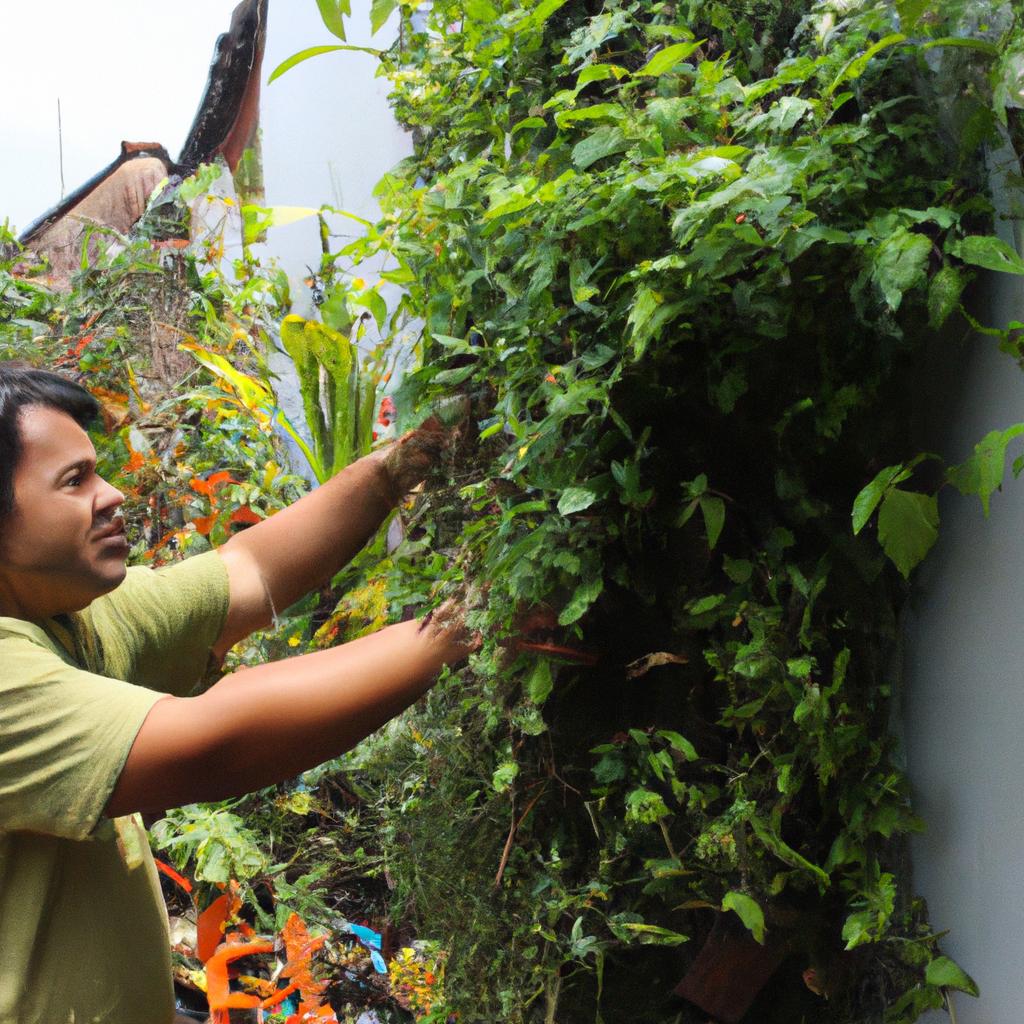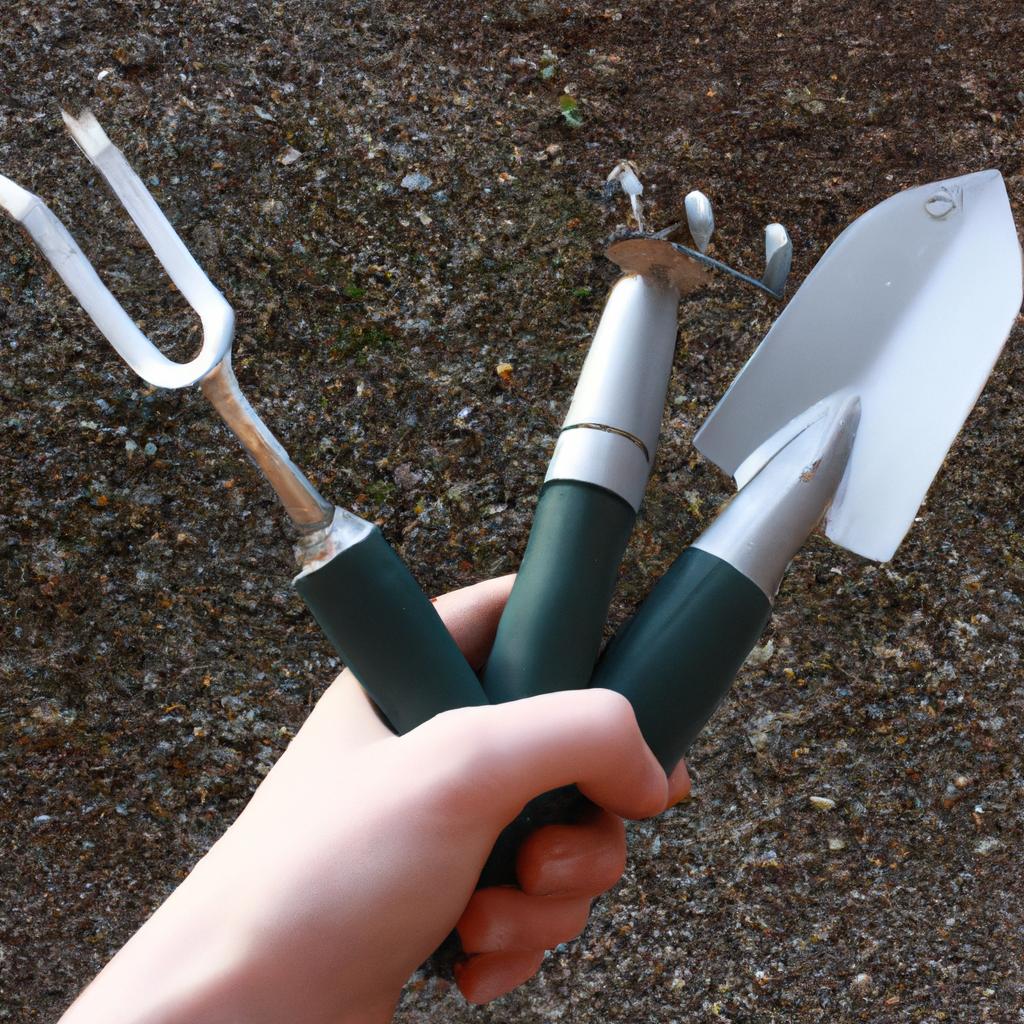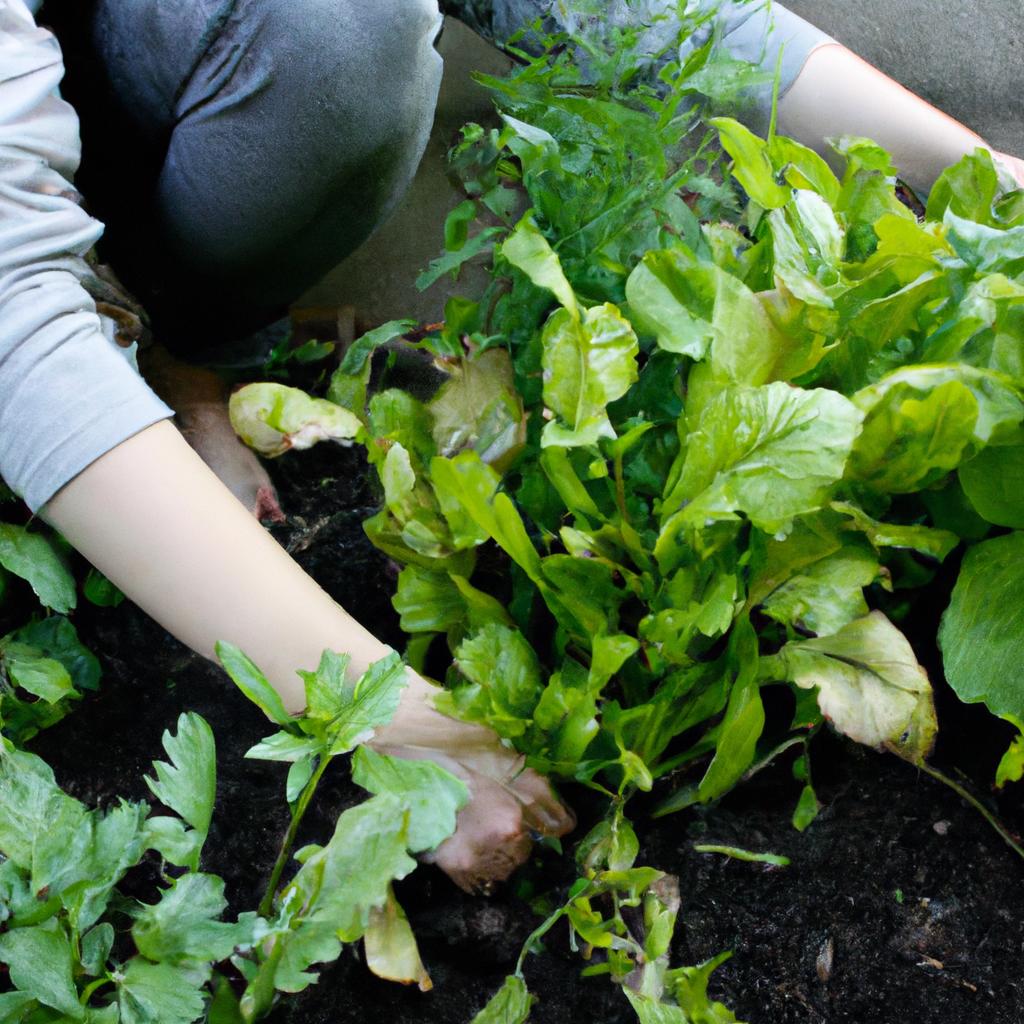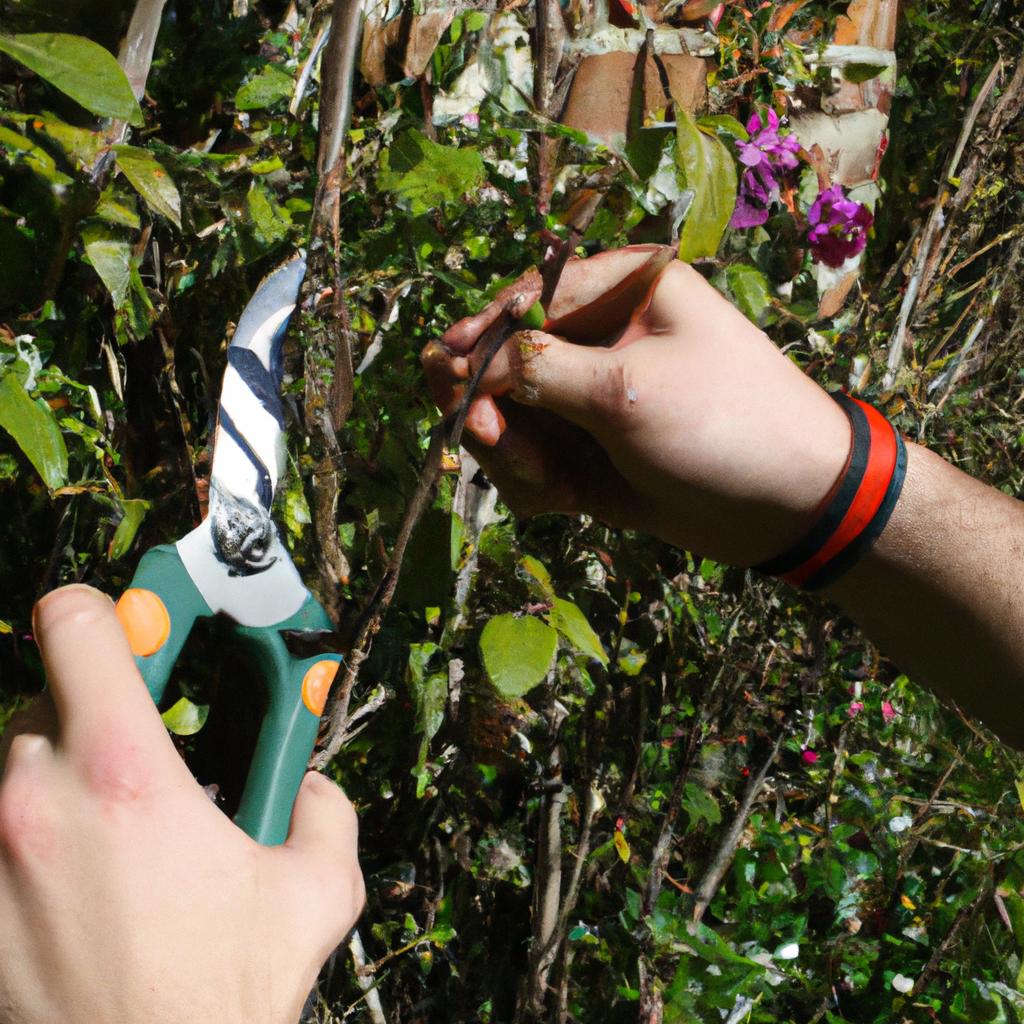Container gardening is a versatile and accessible form of gardening that offers numerous benefits, including recreational enjoyment and the production of fresh food. By utilizing containers such as pots, planters, or hanging baskets, individuals can cultivate plants in limited spaces like balconies, rooftops, or small yards. For instance, imagine a city dweller living in an apartment with only a tiny balcony; through container gardening, they can transform this humble outdoor space into a vibrant oasis filled with blooming flowers and delicious herbs.
Recreation plays a significant role in the appeal of container gardening. Engaging in this activity allows individuals to connect with nature while simultaneously beautifying their surroundings. The act of planting seeds and nurturing them as they grow provides a sense of accomplishment and satisfaction. Moreover, observing the growth process from seedlings to full-grown plants can be both mesmerizing and therapeutic. Container gardens offer opportunities for creativity by allowing gardeners to experiment with various plant combinations, colors, textures, and styles. Whether one chooses to create an elegant flower display or a functional vegetable garden on their patio, container gardening encourages self-expression through horticulture.
Furthermore, container gardening serves as not only an aesthetically pleasing hobby but also a source of nutritious food. Growing edible crops within containers allows individuals to have access to fresh and organic produce right at their fingertips. Whether it’s growing herbs like basil, mint, or parsley for seasoning dishes or cultivating vegetables such as tomatoes, peppers, or lettuce for salads, container gardening provides a convenient way to incorporate homegrown ingredients into one’s diet.
Container gardens can also be tailored to fit specific dietary needs or preferences. For example, individuals following a plant-based diet may choose to grow a variety of leafy greens like spinach, kale, and Swiss chard. Those with limited space can still enjoy the benefits of container gardening by growing compact varieties of fruits and vegetables that thrive in small containers, such as cherry tomatoes or mini bell peppers.
In addition to the accessibility and versatility of container gardening, there are practical advantages as well. Containers can be easily moved around to optimize sunlight exposure or protect plants from extreme weather conditions. They also offer better control over soil quality and drainage compared to traditional in-ground gardening.
Overall, container gardening is an enjoyable and rewarding activity that allows individuals to connect with nature, beautify their surroundings, and produce their own fresh food. Whether you have a spacious backyard or just a tiny balcony, container gardening offers a creative and accessible solution for those looking to experience the joys of gardening in any setting.
Choosing the right containers
Choosing the right containers plays a crucial role in successful container gardening. The type of container you select will impact various aspects of your plants’ growth, including their health and overall productivity. To illustrate this, let’s consider a hypothetical case study: Jane, an avid gardener with limited outdoor space, decided to experiment with container gardening on her apartment balcony. She carefully selected different containers based on their sizes, materials, and drainage capabilities.
One important consideration when choosing containers is size. Different plants have varying root systems and require adequate room for growth. For instance, larger vegetables like tomatoes or peppers need deep containers that can accommodate their extensive root networks. On the other hand, herbs such as basil or parsley thrive in smaller pots due to their shallower roots. By selecting appropriately sized containers for each plant variety, gardeners can ensure optimal conditions for growth and prevent overcrowding.
Material choice also impacts container gardening success. Containers made from materials like plastic or fiberglass tend to retain moisture better than those made of terracotta or metal. This characteristic can be advantageous for water-loving plants but may lead to overwatering if not monitored closely. Conversely, terracotta or metal containers allow excess moisture to evaporate more quickly, making them suitable for plants that prefer drier soil conditions. Understanding the material properties helps gardeners make informed decisions about which plants would thrive best in specific types of containers.
Drainage is another critical factor when it comes to selecting containers. Good drainage prevents waterlogging and ensures healthy root development by allowing excess water to escape freely from the bottom of the pot. Without proper drainage holes or a layer of gravel at the bottom of the container, stagnant water may accumulate around the roots, leading to rotting and disease susceptibility. Gardeners must prioritize containers with sufficient drainage capacity to provide an ideal growing environment for their plants.
In summary, choosing the right containers involves considering factors such as size, material composition, and drainage capabilities. By matching containers to the specific needs of different plants, gardeners can create a suitable environment for growth and maximize their gardening success.
- Emotional bullet point list:
- Enhance your gardening experience by selecting containers that promote healthy plant growth.
- Create an attractive and personalized garden space using a variety of container sizes and materials.
- Ensure optimal conditions for your plants’ root systems by choosing appropriately sized pots.
- Prevent water-related issues like overwatering or root rot with well-draining containers.
Moving forward into the next section about “Selecting the appropriate soil mix,” it is important to understand how the chosen container influences the type of soil needed for successful container gardening.
Selecting the appropriate soil mix
Building upon the importance of choosing the right containers for your container gardening journey, let us now delve into another crucial aspect – selecting the appropriate soil mix. To illustrate its significance, consider a hypothetical scenario where two gardeners decide to grow tomatoes in containers. Gardener A chooses an ordinary potting soil mix while Gardener B opts for a specially formulated tomato soil mix. The results? Gardener B’s plants thrive with healthy foliage and abundant fruit production, while Gardener A experiences stunted growth and lackluster harvests.
The success or failure of your container garden largely depends on the quality of the soil mix you choose. Here are some key factors to consider when selecting an appropriate soil mix:
- Nutrient content: Look for a soil mix that is rich in organic matter and essential nutrients like nitrogen, phosphorus, and potassium. These nutrients are vital for plant growth and overall health.
- Water retention: The ability of the soil mix to retain water is critical as it ensures consistent moisture levels for your plants without excessive drying out or waterlogging.
- Drainage capacity: Adequate drainage is necessary to prevent root rot caused by excess water accumulation. Ensure that the soil mix allows water to flow freely through it.
- pH balance: Different plants have different preferences regarding soil acidity or alkalinity. Consider testing your chosen soil mix’s pH level before planting to ensure compatibility with your desired crops.
- Choose a nutrient-rich soil mix
- Opt for good water retention capabilities
- Ensure proper drainage
- Check pH balance suitability
In addition to these factors, understanding how various components work together within a well-balanced mixture can be beneficial. Take a look at this table showcasing common ingredients found in a typical high-quality potting soil:
| Component | Function | Emotional Response |
|---|---|---|
| Peat moss | Improves moisture | Comfort |
| Perlite | Enhances drainage | Relief |
| Compost | Adds nutrients | Nourishment |
| Vermiculite | Retains water | Hydration |
By carefully considering these factors and selecting an appropriate soil mix, you lay the foundation for healthy plant growth in your container garden. With the right combination of nutrients, good water retention, proper drainage, and suitable pH balance, your plants will have a solid base to thrive upon.
Now that we have covered the importance of choosing the right containers and selecting an appropriate soil mix, let’s move on to picking the right plants for your container garden.
Picking the right plants
Transitioning from selecting the appropriate soil mix, it is now crucial to choose the right plants that will thrive in your container garden. To illustrate this point, let’s consider a hypothetical scenario where you have limited sunlight on your balcony due to surrounding buildings. In such a case, opting for shade-loving plants like ferns and impatiens would be more suitable than sun-loving varieties such as tomatoes or peppers.
When selecting plants for your container garden, keep in mind these key considerations:
- Space requirements: Some plants grow larger than others and may require more room to spread their roots. Be mindful of choosing compact varieties for smaller containers or opt for larger pots if you wish to accommodate bigger plants.
- Climate suitability: Different plant species have varying temperature preferences. Ensure that the selected plants can tolerate the climate conditions of your region, especially if you plan on moving them outdoors during warmer months.
- Watering needs: Certain plants are more drought-tolerant and require less frequent watering, while others need consistent moisture levels. Consider how often you’ll be able to water your container garden when choosing plant types.
- Complementary growth habits: Pairing plants with similar growing patterns can enhance visual appeal and promote better overall health within the container. For instance, combining trailing vines with upright flowers creates an attractive cascading effect.
To further illustrate the potential choices available when picking plants for your container garden, refer to the following table:
| Plant Name | Sunlight Requirement | Height (inches) | Special Care |
|---|---|---|---|
| Petunia | Full sun | 8-12 | Deadheading* |
| Hosta | Shade/part shade | 16-36 | Mulching** |
| Rosemary | Full sun | 24-48 | Pruning*** |
| Marigold | Full sun | 6-36 | Deadheading* |
*A process of removing wilted flowers to encourage new blooms.
**Covering the soil around the plant with organic materials, such as wood chips or compost, to retain moisture and suppress weeds.
***Trimming off excessive growth to maintain shape and promote healthy foliage.
By carefully selecting plants that suit your specific growing conditions and considering their unique characteristics, you can create a vibrant and thriving container garden.
Providing proper watering
After carefully selecting the right plants for your container garden, it is crucial to ensure they receive appropriate watering. By providing adequate moisture, you can support healthy growth and prevent wilting or dehydration. Let’s explore some essential tips for effective watering in container gardening.
Example: Imagine you have a vibrant tomato plant thriving in a large pot on your patio. To keep it flourishing, you need to maintain consistent soil moisture levels. This will help the plant absorb nutrients efficiently and continue producing juicy tomatoes throughout the season.
Firstly, consider these key points when determining how much water your container garden needs:
- Plant requirements: Different plants have distinct water needs based on their species and size. Research specific guidelines for each type of plant in your garden to ensure optimal watering.
- Environmental factors: Factors like temperature, humidity levels, and sun exposure affect how quickly water evaporates from containers. Adjust your watering frequency accordingly during hot weather or dry spells.
- Container material: The type of container used can impact water retention and drainage. Porous materials such as terracotta may require more frequent watering than plastic pots with drainage holes.
- Soil composition: Well-draining soil mixtures are essential for container gardens as they allow excess water to escape easily while retaining enough moisture for root absorption.
To provide proper hydration for your plants, follow these general steps:
| Watering Tips | Benefits |
|---|---|
| Water deeply | Encourages deep root growth |
| Monitor soil moisture | Prevents over or under-watering |
| Use drip irrigation | Promotes efficient water distribution |
| Mulch around plants | Helps retain soil moisture |
By adopting these practices, you can establish an effective routine that supports the health and vitality of your container garden.
As we move forward into our next section about ensuring adequate sunlight, remember that maintaining proper watering techniques goes hand-in-hand with providing ideal growing conditions for your plants.
Ensuring adequate sunlight
Building on the importance of providing proper watering, another crucial aspect of container gardening is ensuring adequate sunlight. Without sufficient exposure to sunlight, plants may struggle to grow and thrive. Let’s explore why sunlight is vital for successful container gardening.
Sunlight plays a pivotal role in photosynthesis, the process by which plants convert light energy into chemical energy to fuel their growth. When plants receive ample sunlight, they are able to produce more food through photosynthesis, resulting in healthier and more productive plant growth. For instance, imagine a scenario where two tomato plants are grown in containers – one positioned in full sun throughout the day while the other is placed under partial shade. The plant receiving abundant sunlight would likely yield larger and tastier tomatoes compared to its shaded counterpart.
To further emphasize the significance of sunlight in container gardening, consider these key points:
- Sun-loving plants: Many common vegetables and herbs thrive when exposed to direct sunlight for at least six hours daily. Examples include tomatoes, peppers, basil, and rosemary.
- Light requirements: Different plant species have varying light requirements. While some can tolerate partial shade or dappled light conditions, others necessitate full sun exposure.
- Positioning containers strategically: Place your containers in areas that receive maximum sunlight based on your specific plant’s needs.
- Utilizing reflective surfaces: Maximize available light by positioning containers near walls painted with light colors or utilizing reflective materials such as aluminum foil around pots.
| Plant | Light Requirements |
|---|---|
| Tomatoes | Full sun |
| Peppers | Full sun/partial shade |
| Basil | Full sun/partial shade |
| Rosemary | Full sun |
By prioritizing adequate sunlight for your container garden, you provide your plants with an essential ingredient for healthy growth. In the subsequent section about managing pests and diseases, we will delve into ways to protect your flourishing garden from potential threats.
Managing pests and diseases
Transitioning from the previous section on ensuring adequate sunlight, it is important to also address the management of pests and diseases in container gardening. Pests and diseases can significantly impact plant health and productivity, therefore implementing effective strategies to prevent and control them is crucial.
To illustrate this point, let’s consider a hypothetical scenario where an avid gardener named Sarah decides to grow tomatoes in containers on her balcony. Sarah carefully selects disease-resistant tomato varieties and ensures they receive ample sunlight throughout the day. However, despite her efforts, she notices that some plants start showing signs of wilting leaves and discoloration. Upon closer inspection, she discovers aphids infesting her tomato plants.
When facing pest invasions or potential disease outbreaks in container gardens, there are several key considerations gardeners should keep in mind:
- Early detection: Regularly inspect your plants for any signs of pests or diseases. Catching issues early allows for prompt action before significant damage occurs.
- Integrated Pest Management (IPM): Implement IPM techniques by combining various preventive measures such as cultural practices (e.g., proper sanitation), biological controls (e.g., introducing beneficial insects), mechanical methods (e.g., handpicking pests), and targeted pesticide use when necessary.
- Proper watering: Avoid overwatering as excessive moisture can create favorable conditions for certain diseases such as powdery mildew or root rot.
- Crop rotation: Rotate crops annually to reduce the risk of recurring pest problems associated with specific plant families.
To further emphasize the importance of managing pests and diseases effectively, consider the following table:
| Pest/Disease | Impact | Prevention |
|---|---|---|
| Aphids | Sap-sucking pests | Encourage natural predators |
| Powdery Mildew | Fungal infection | Provide adequate air circulation |
| Caterpillars | Leaf-eating pests | Handpick or use organic insecticides |
| Blossom End Rot | Calcium deficiency | Maintain consistent watering |
In conclusion, while container gardening offers numerous benefits, it is essential to address pest and disease management. Early detection, implementing integrated pest management techniques, proper watering practices, and crop rotation are key strategies for maintaining healthy plants. By being proactive in preventing and controlling these issues, gardeners can ensure the success of their container gardens and enjoy bountiful harvests.
Note: The markdown format cannot be displayed here as plain text. Please refer to a markdown editor or viewer to visualize the bullet point list and table layout properly.
 Refoksa
Refoksa



